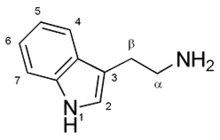Indolamines
From Wikipedia, the free encyclopedia

Tryptamine - otherwise known as indolamine.
Indolamines are a family of neurotransmitters that share a common molecular structure (namely, indolamine). A common example of an indolamine is serotonin, a neurotransmitter involved in mood and sleep. Another example of an indolamine is melatonin, which regulates the sleep-wake cycle (circadian rhythm) in humans.
In biochemistry, indoleamines are substituted indole compounds that contain an amino group. Examples of indoleamines include the lysergamides.
Synthesis

The pathway for the synthesis of serotonin from tryptophan. Note that all compounds shown are indolamines.
In humans, neurotransmitters in the indolamine family are believed to be produced in the pineal gland.[citation needed] Indolamines are biologically synthesized from the essential amino acid tryptophan.
See also
This article is issued from Wikipedia. The text is available under the Creative Commons Attribution/Share Alike; additional terms may apply for the media files.